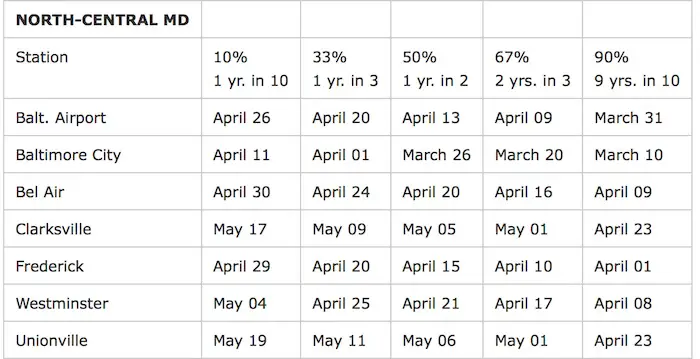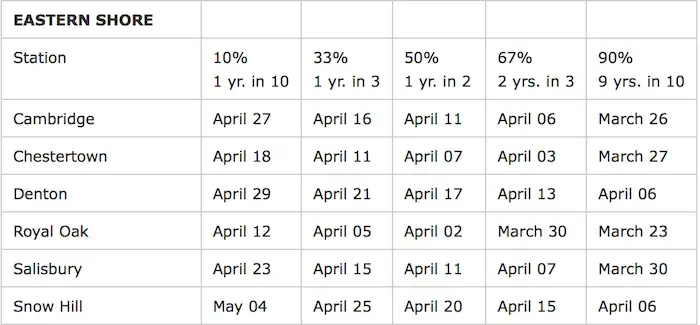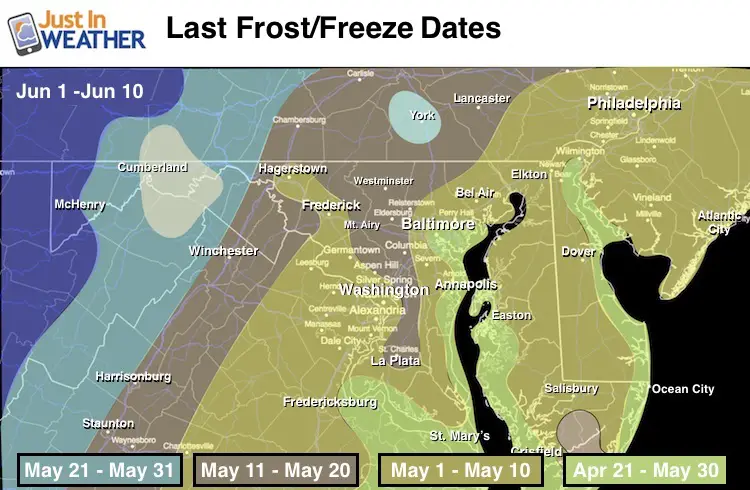There is a good reason why many gardeners suggest NOT to plan tomatoes until after Mother’s Day. Early surges of warm air in spring can be deceiving. Just because the temperatures reach the 80s or even 90ºF does not mean we safely into the growing season. In fact often an abnormal warm up in March or April can be matched by an equally abnormal cool down as the atmosphere tries to balance itself out. A late frost or freeze is still possible and can harm or kill plants, even as we head into warmer months. So getting gardens ready can take an effort in trust and patience.
Air temperatures are measured at 5 to 6 feet above the ground. On a chilly morning, it could be 5 degrees or more colder on the ground than the air at the thermometer’s level. That can allow frost to develop on grass and cars while the air is in the upper 30s. A freeze is when the air itself is at or below 32ºF. This is more threatening to garden plants.
Whenever I make an average map of anything weather related in Maryland, is is colorful. There is such a wide variety of conditions thanks to the contrast from the mountains, valleys, foothills, Chesapeake Bay, all the rivers and tributaries, and the Atlantic Ocean. This does extend across to Pennsylvania and Virginia, but tightly packed contours in central Maryland reflect how difficult weather forecasting can be.
Here is a look at the ‘last’ frost and freeze dates in our region. This is when most planting can be considered safe outside. Note, this is the extreme and the ‘safe bet’ Below is a breakdown of dates the last frost or freeze that are more common for towns and cities in Maryland thanks to the University of Maryland.



Also see: Average First Frost/Freeze Map and Dates (for end of the growing season in Autumn)
Please share your thoughts, best weather pics/video, or just keep in touch via social media
-
Facebook: Justin Berk, Meteorologist
-
Twitter: @JustinWeather
-
Instagram: justinweather
 Get the award winning Kid Weather App I made with my oldest son and support our love for science, weather, and technology. Our 3 year anniversary of the release and our contribution to STEM education is this November. It has been downloaded in 60 countries, and works in both temperature scales. With your support we can expand on the fun introduction to science and real weather.
Get the award winning Kid Weather App I made with my oldest son and support our love for science, weather, and technology. Our 3 year anniversary of the release and our contribution to STEM education is this November. It has been downloaded in 60 countries, and works in both temperature scales. With your support we can expand on the fun introduction to science and real weather.
-
Sign up for email updates on new posts
Since you may miss some posts via social media, click here for email alerts as a way to make sure you don’t miss any. *You may have to refresh that page once for your browser to clear out the images.
Faith in the Flakes
The store is open between November and March.
Also See:


